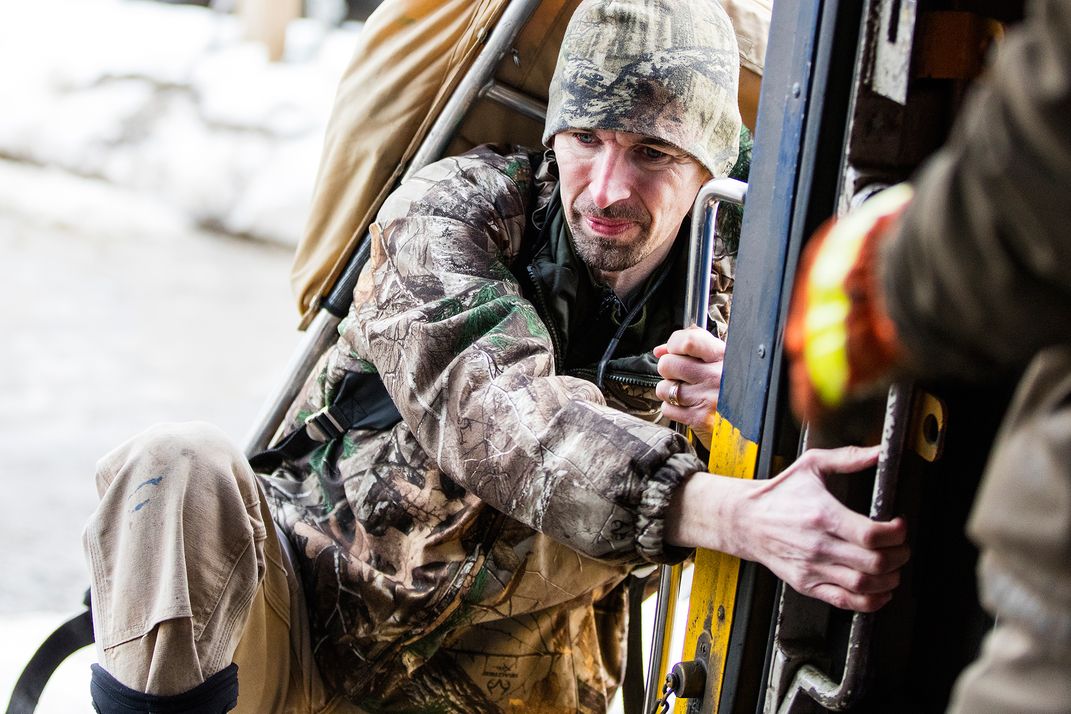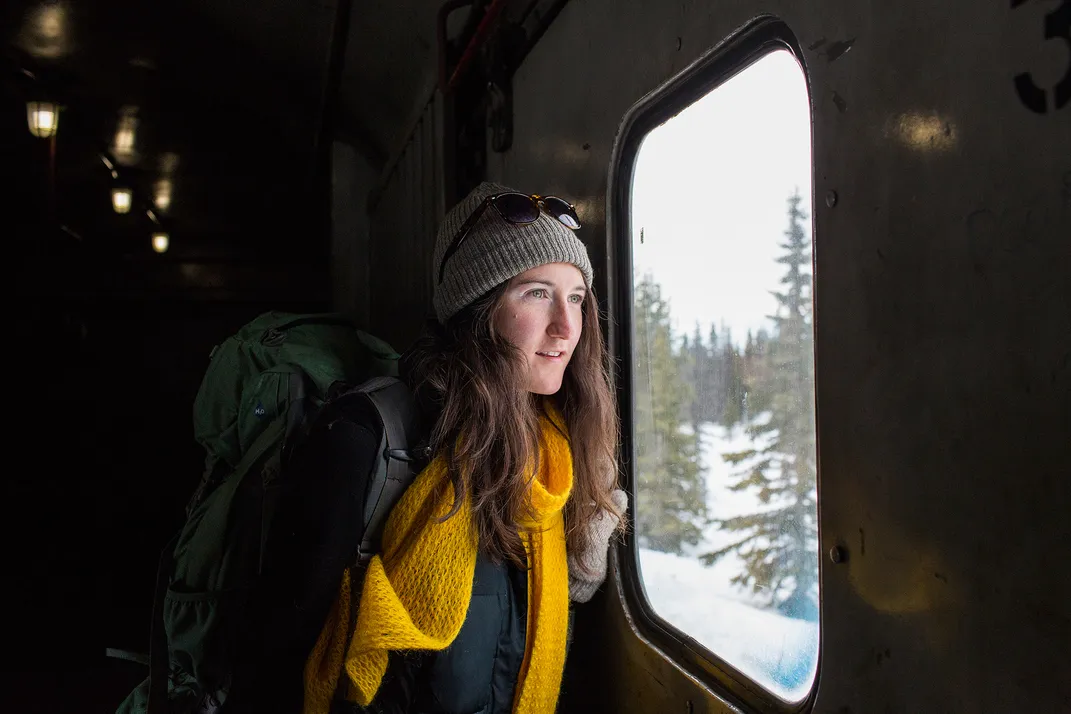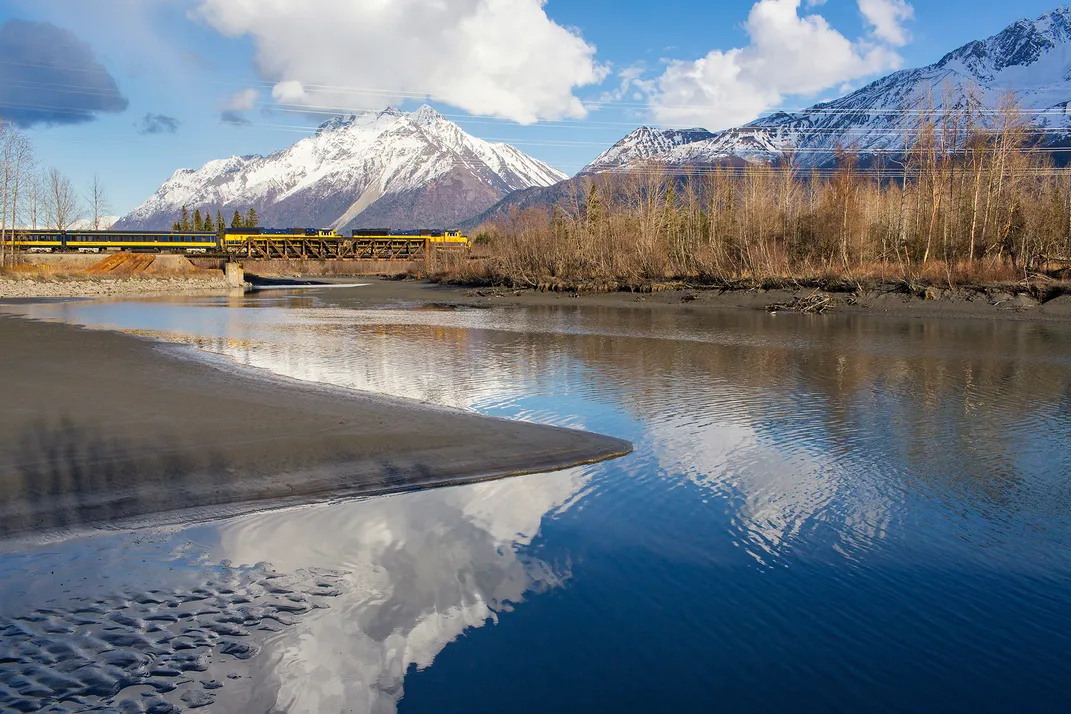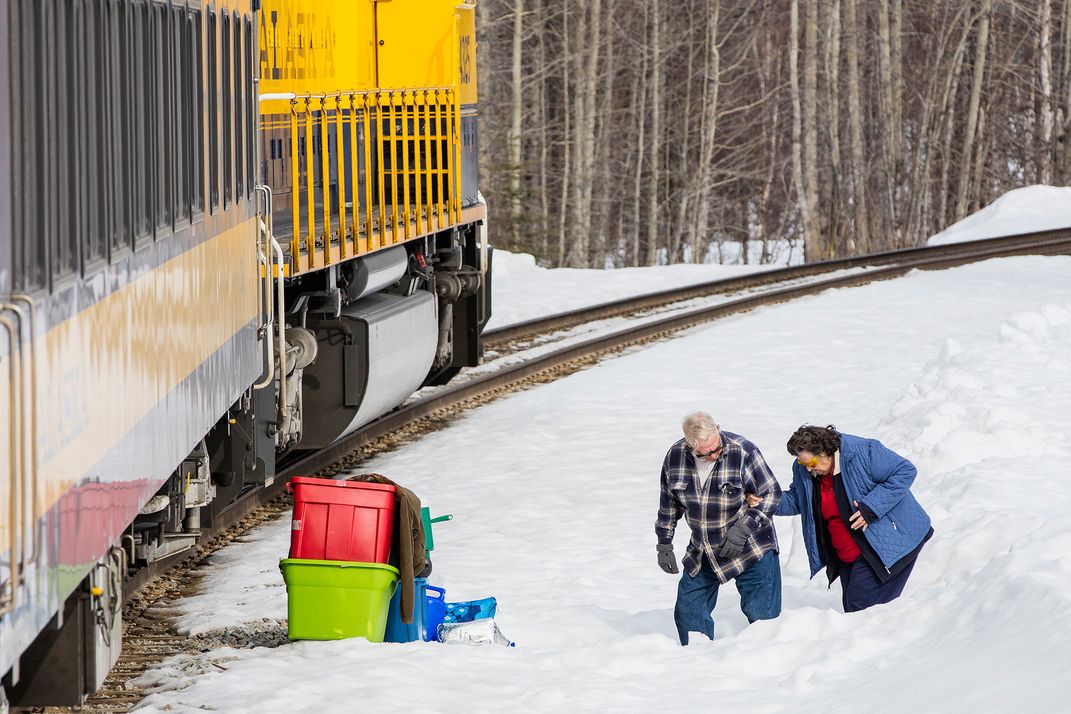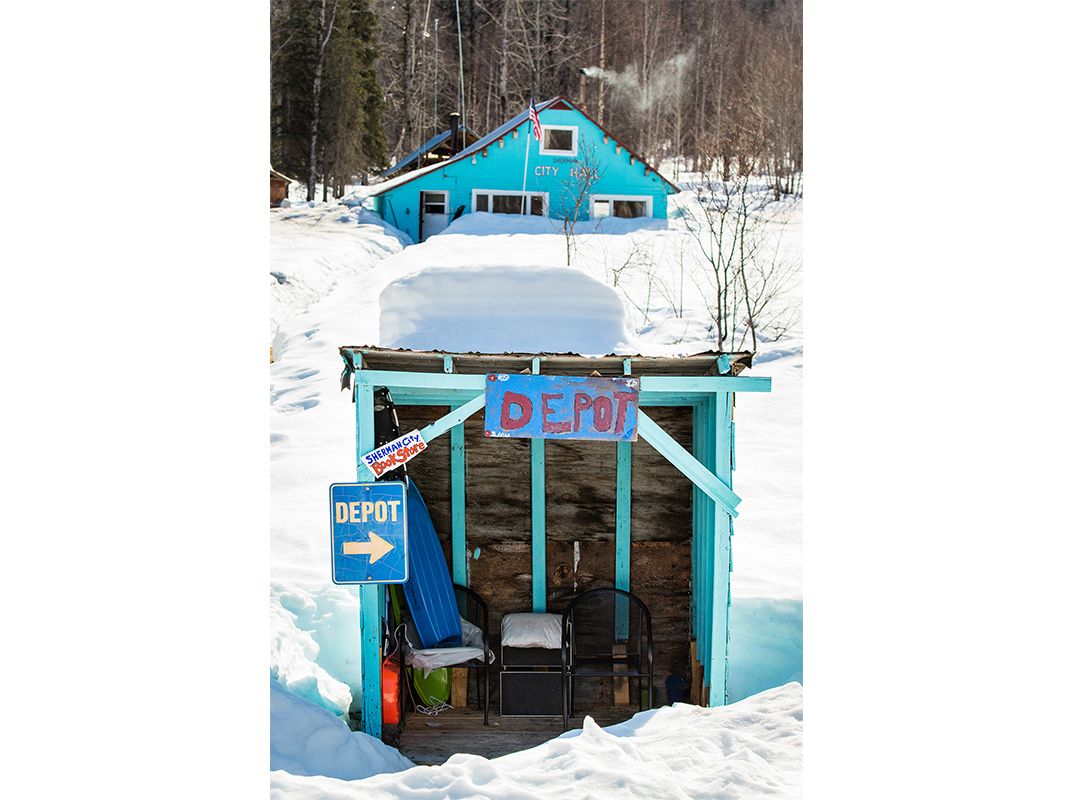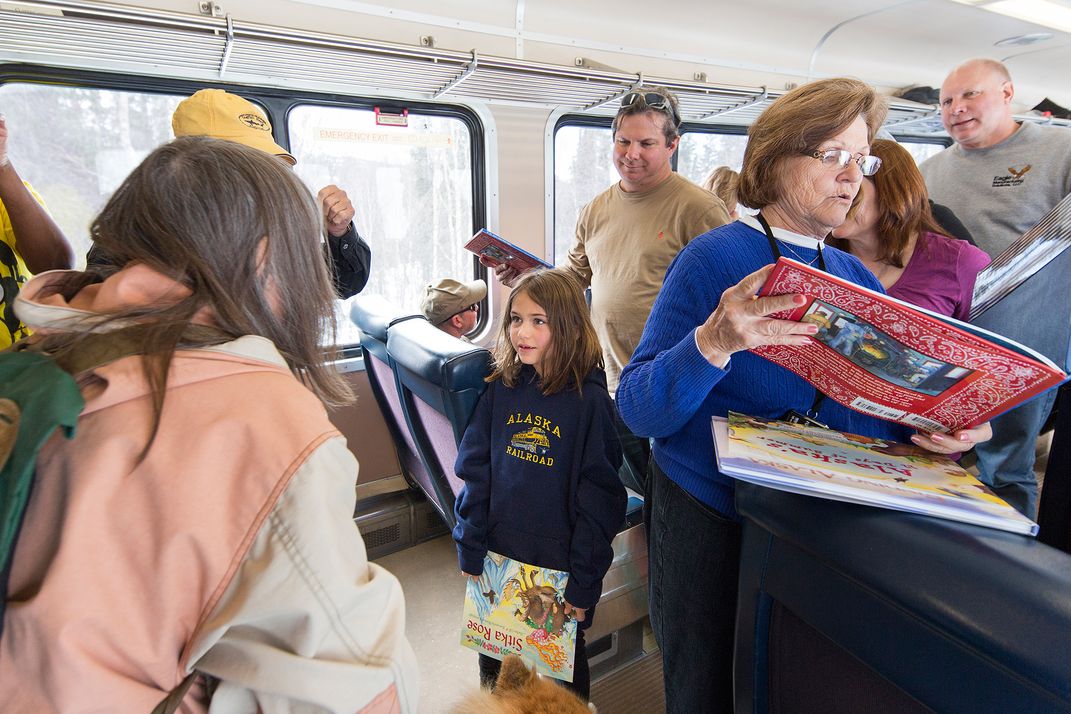For a Truly Authentic Alaskan Experience, Hop Aboard America’s Last Flag-Stop Train
Reaching off-the-grid homesteads and cabins, the Hurricane Turn train stops for anyone who flags it down
:focal(178x290:179x291)/https://tf-cmsv2-smithsonianmag-media.s3.amazonaws.com/filer/8e/c7/8ec70842-4a25-409e-867f-06aa3e022ee3/sqj_1607_alaska_train_01-v3.jpg)
To get to the town of Talkeetna, where Alaska’s popular flag-stop train begins its route, take the Parks Highway north from Anchorage through the Anywhere-in-America strip-mall colony of Wasilla, pass Happy Hooker Towing and the neighboring Church on the Rock, go by so many lonesome coffee carts in so many dusty gravel parking lots you’ll lose count and on through the town of Houston, where kids on four-wheelers race down the roadside, kicking up dust.
Keep driving as these touches of urban living give way to a rolling tapestry of silver-bark birches. When you get to the stretch where trees were torched into black spindles by wildfire last summer, you’re close. Maybe then, up over a rise in the highway, you will get a glimpse of Denali’s unreal height, its snow-smoothed shoulders holding the weight of a wide, blue sky.
It had been a quarter of a century since I’d been to Talkeetna. Now, I was going there to catch the Hurricane Turn and ride 55 miles north through a series of off-the-grid homesteads to Hurricane Gulch. There the railcars would stop atop a bridge over a 300-foot drop to Hurricane Creek before turning around. It’s said to be the last flag-stop train route in America, a six-hour trip into a simpler, elemental way of life. The train, which stops for anyone who waves it down, runs Thursday through Sunday all summer. In winter it goes once a month.
Some of what I know about this part of Alaska comes from a stack of letters my parents exchanged one summer in the 1970s, early in their marriage. My mother was working at an inn in Talkeetna. My dad was laying culverts somewhere on Alaska’s North Slope, one of tens of thousands of men building the trans-Alaska oil pipeline. His father, Old Doc, was staying out at the inn, trying to recover after some strokes. He would pass away before the end of the summer.
I was in college when I first pored over my parents’ cursive accounts. They’d been divorced for five or six years, and I yearned for clues about what had existed between them. I wanted song lyrics or poetry or, at the very least, passages about their mutual longing. What I got instead was Mom describing a no-nonsense innkeeper nicknamed Evil Alice, who taught her how to make blueberry pie. Mornings at the inn, she wrote, smelled like Yuban, bacon, and sourdough. Five hundred-some miles north, Dad cataloged the movies played in the evenings and looked forward to when the camp kitchen served steak. Send me whiskey, he wrote, and a new pair of jeans.
Each knew, in mundane detail, how the other spent the day. A care package sent from Talkeetna up to a campsite on the tundra was its own straightforward sonnet. You can forget, as the years pass and the distractions grow, the importance of simple gestures, both practical and kind.
Talkeetna sits on the bank of the Susitna River where it converges with the Chulitna and Talkeetna Rivers, in an area that was originally inhabited by the seminomadic Athabaskan Indians. The modern town’s roots go back about a hundred years, to the time when miners were looking for gold nearby and the government built a railroad from the port of Seward in the south to Fairbanks in the interior. Today, Talkeetna still has the old-timey feel of a TV Western. Many of the original businesses are still there, fashioned out of weathered logs and leaning clapboard: Nagley’s Store, the Fairview Inn. About 900 people live in the area, and tourism is the main industry. There’s a nice lodge and a popular local brewery. Talkeetna is also a stop for climbers on the way to summit Denali.
Once the area was a place of promise for settlers pinning their future on the Homestead Act, signed by Abraham Lincoln in 1862. The grant program allowed people to lay claim to land by meeting certain requirements, like living on it and cultivating it. Homesteading was allowed in Alaska longer than in any other state; it officially ended here in 1986. By that time the independent spirit that came with it was built into the state’s DNA.
The way I understand it, Evil Alice and her husband had a homestead called Fish Lake on the flag-stop route just south of Talkeetna. My dad and his eight brothers and sisters would often be sent from their home in Anchorage to give my grandmother a hand. Alice had been a good friend of my grandfather. They are both long buried.
I once asked my dad and my uncle Tommy the procedure for stopping a train, and they gave me identical answers. First, Tommy said, you had to wait at the tracks until you saw it. Then, Dad said, you’d usually wave a flag. Back in the day, it was green and white. You’d keep waving, Tommy said, until you heard the whistle.
“You’ll be able to tell the locals at the train station,” Tommy told me, “because they’ll be the ones getting on with big Rubbermaid tubs. Everything out there has to come with you on the train. It makes you think about what you really need.”
When I got to town, I found Nancy James sitting on a concrete planter with her gear, waiting for the train. She said she and her husband, Jim James, who were 62 and 69, had come to Alaska from Illinois more than 20 years earlier. Jim had a white beard, a wide-brimmed hat, and a hook in place of his left hand.
The train rolled up, we boarded, and I sat by the Jameses. They’d come to Alaska looking to get away from the world, but they’d both become mildly famous after being featured on the reality-TV show Railroad Alaska. Later, looking at a clip of the show online, I learned that Jim had lost his hand in a mishap with a shotgun.
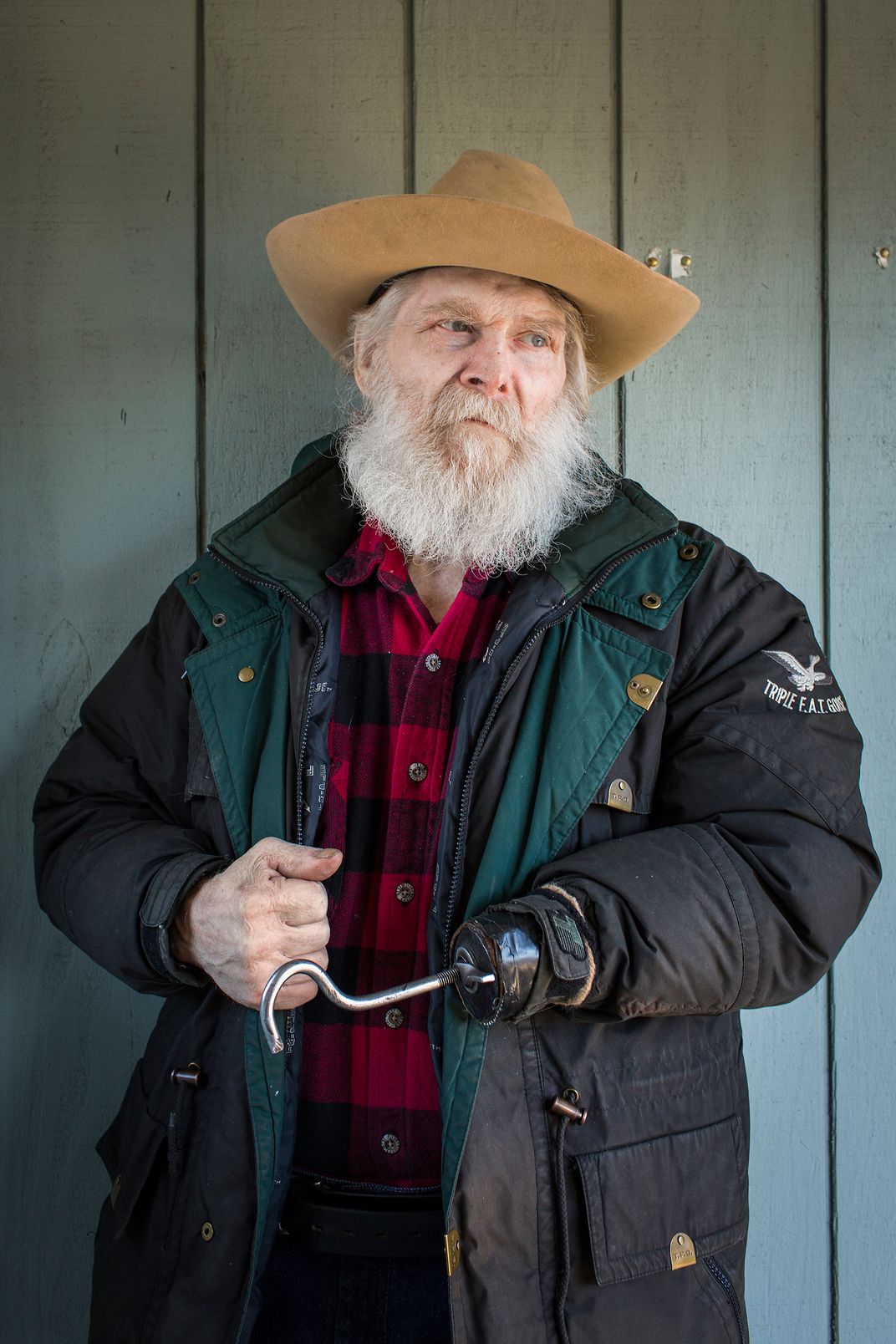
One of the ironies about modern-day Alaska is the prevalence of reality TV. The farther off the road you get, the more likely you are to stumble onto the trail of television producers. Isolation, hard work, and survival make good shows, but through the lens of cable, life always comes out a few tints off. The Jameses seem more severe on-screen than in real life. I asked what they’d tell a couple who wanted to move off the grid.
“Oh, that would take two or three trips back and forth to Hurricane to tell you,” Jim said.
“Make sure you’re compatible,” Nancy said, and left it at that.
Their days on the homestead are filled with work, they told me. They have to haul water and fuel. Chop firewood. Stack firewood. The bugs are outrageous. Still, Nancy told me, “It’s easier living out there than in the city.”
The Jameses’ stop came up, and a train employee bid them farewell over the loudspeaker. My car was occupied by a traveling club of retirees from Anchorage. The group crowded to one side of the car to take cell phone pictures of the couple as they trudged off through the wet snow.
Jill and Dan Adamson and their black Lab, Murphy, rode in the baggage area, as most of the locals did. Jill and Dan are in their 50s—a retired nurse and a firefighter, with a cabin on the flag-stop route and a place in Talkeetna. Jill figured they’d started working to build a cabin on their land 20 years ago.
“You gotta clear it,” she said. “You gotta plan it. You gotta haul it. You gotta put it together piece by piece.”
They had themselves set up now, she said. Propane stove. Generator. Rain-catch water. A sauna. Mobile devices don’t work at the cabin, she said. You shift to another time zone. She called it event time.
“Event time is when you got up, when you went to the shitter, when you stoked the woodstove,” she said. “It doesn’t matter until you have to catch the train what time it is.”
There wasn’t any drama out there, she said. Except the occasional black bear. “We don’t mind the grizzlies. They just kind of wander through,” she said. ”But the blacks can be trouble.” A neighbor shot one a few summers back. Dressed it out, she said. Shared the meat.
As the train made its way through the trees, threading together barely populated map-point communities—Sherman, Gold Creek, Twin Bridges, Chulina—we dropped off some government hydrologists, some weekend cabin people with sleds full of firewood, and a few homesteaders with their plastic tubs. One of them was met by a woman wearing a sidearm, to the delight of the travel clubbers around me. Soon the train stopped and I went out to the open vestibule between the cars, inhaling the cool, thin air.
Below the railroad bridge was a steep drop down to a half-frozen creek in Hurricane Gulch. A valley opened out ahead, and beyond that rose the electric-white contours of a faraway range. Taking in a massive wild landscape does something to your thinking. It gives you perspective, rare and valuable as a gold nugget glinting in soft river sand. As the train lurched into action, a phrase rolled through my head: You are small, you are small, you are small.
Mary and Clyde Lovel were helped onto the train by a bevy of railroad people. She was about to turn 80, and he was pushing 88. They’d lived more than 50 years off the track, raising four children. Mary had written books based on letters she sent her family in the early days. They hadn’t spent much time out there over the winter, for health reasons. It gets harder as you age, she said. I asked what made them keep coming out.
“We feel closer to God, really, you know?” she said.
After that an old-timer in a soft-edged Carhartt jacket came on. He wouldn’t give his name. Too many outsiders coming on the train, getting the story wrong, he said. I asked if he’d known my grandfather Old Doc and Evil Alice. “Those were your people?” he said. He remembered Fish Lake and said it was probably Old Doc who’d given Alice her unusual nickname. (I found out later that Alice once worked as a health inspector and had a reputation for shutting down bars. Because of that, Old Doc called her “evil.” )
The old-timer’s thoughts headed down a trail to an unseen destination. “I remember Alice dancing at the Fairview,” he said. “She used to like to dance.” I imagined Alice and Old Doc as younger people, sitting inside a Talkeetna inn, their lives still spooling out ahead of them.
Earlier we’d picked up Shannon Cartwright, a children’s book illustrator I’d been familiar with since I was a kid, and her big fluffy dog, Coda. The train was her way of socializing, she told me. She’d lived full-time on the flag-stop for 38 years and illustrated 26 books out there. She had no cell phone or Internet.
“People that I sell books to say, ‘Well, can we email you? Can we fax you?’ ‘No,’ ” she said. “ ‘Can I send it to you in the mail?’ ‘Yes, the U.S. mail. The train will throw my mail out for me.’ ”
She hasn’t had a television in 50 years. I thought about how rare that was now, to live in isolation from technology and manage to work. I’ve traveled to some pretty small, remote places in far-north Alaska. Even houses without working toilets had a TV, and it was usually on, connecting people to a wider world.
“I haul water from the river,” she said. “I sled to the outhouse. It’s just fun. Life is fun. Life is simple.”
Cartwright and the Lovels had moved off the track when people were still carving out pieces of the state for themselves. Alaska was huge. Infrastructure was sparse. The state had changed. This stretch of track reminded me of an oasis in a Hawaiian lava field I’d hiked through once, an exotic island of untouched ancient forest full of endangered birds, like a living time capsule.
Cartwright told me that she still grew her own vegetables. She published her own books and set her own deadlines. Only trouble was, she was getting older. Her nearest neighbor was a mile away. Her satellite phone didn’t always work.
“I try to stay in shape,” she said. “So I can live out here forever.”
She glanced down the train car. The window filled her pale eyes with light. She’d like to talk more, she said, but she had to pack up her tub. Her stop was up next.
Read more from the Smithsonian Journeys Travel Quarterly Alaska Issue
Planning Your Next Trip?
Explore great travel deals
Smithsonian magazine participates in affiliate link advertising programs. If you purchase an item through these links, we receive a commission.
